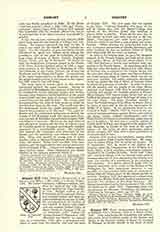

Gregory XIV, POPE NICCOLO SFONDRATI), b. at Somma, near Milan, February 11, 1535; d. at Rome, October 15, 1591. His father Francesco, a Milanese senator, had, after the death of his wife, been created cardinal by Pope Paul III, in 1544. Niccolo studied at the Universities of Perugia and Padua, was ordained priest, and then appointed Bishop of Cremona, in 1560. He participated in the sessions of the Council of Trent, 1561-1563, and was created Cardinal–Priest of Santa Cecilia by Gregory XIII on December 12, 1583. Urban VII having died on September 27, 1590, Sfondrati was elected to succeed him on December 5, 1590, after a protracted conclave of more than two months, and took the name of Gregory XIV. The new pope had not aspired to the tiara. Cardinal Montalto, who came to his cell to inform him that the Sacred College had agreed on his election, found him kneeling in prayer before a crucifix. When on the next day he was elected he burst into tears and said to the cardinals: “God forgive you! what have you done?” From his youth he had been a man of piety and mortification. Before entering the ecclesiastical state he was a constant companion of Charles Borromeo, and when cardinal, he was an intimate friend of Philip Neri whose holy life he strove to imitate.
As soon as he became pope, he gave his energetic support to the French League, and took active measures against Henry of Navarre, whom Sixtus V, in 1585, had declared a heretic and excluded from succession to the French throne. In accordance with the Salic law, after the death of Henry III in 1589, Henry of Navarre was to succeed to the French throne, but the prevalent idea of those times was that no Protestant could become King of France, which was for the most part Catholic. The nobles, moreover, threatened to rise up against the rule of Henry of Navarre unless he promised to become a Catholic. In order to reconcile the nobility and the people to his reign, Henry declared on August 4, 1589, that he would become a Catholic and uphold the Catholic religion in France. When Gregory XIV became pope, Henry had not yet fulfilled his promise and gave little hope of doing it in the near future. The pope, therefore, decided to assist the French League in its efforts to depose Henry by force of arms and in this he was encouraged by Philip II of Spain. In his monitorial letter to the Council of Paris, March 1, 1591, he renewed the sentence of excommunication against Henry, and ordered the clergy, nobles, judicial functionaries, and the Third Estate of France to renounce him, under pain of severe penalties. He also sent a monthly subsidy of 15,000 scudi to Paris, and dispatched his nephew Ercole Sfondrati to France at the head of the papal troops. In the midst of these operations against Henry, Gregory XIV died, after a short pontificate of 10 months and 10 days.
Gregory XIV created five cardinals, among whom was his nephew Paolo Camillo Sfondrati. He vainly tried to induce Philip Neri to accept the purple. On September 21, 1591, he raised to the dignity of a religious order the Congregation of the Fathers of a Good Death (Clerici regulares ministrantes infirmis) founded by St. Camillus de Lellis. In his Bull “Cogit nos”, dated March 21, 1591, he forbade under pain of excommunication all bets concerning the election of a pope, the duration of a pontificate, or the creation of new cardinals. In a decree, dated April 18, 1591, he ordered reparation to be made to the Indians of the Philippines by their conquerors wherever it was possible, and commanded under pain of excommunication that all Indian slaves in the islands should be set free. Gregory XIV also appointed a commission to revise the Sixtine Bible and another commission to continue the revision of the Pian Breviary. The former commission had its first session on February 7, 1591, the latter on April 21, 1591. Concerning these two commissions see Baumer, “Geschichte des Breviers” (Freiburg im Breisgau, 1895), pp. 479-90.
MICHAEL OTT

